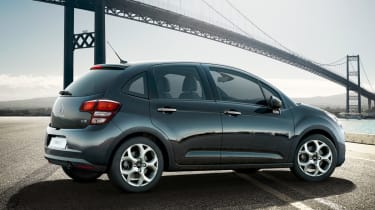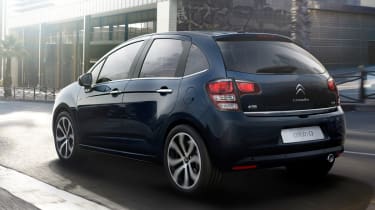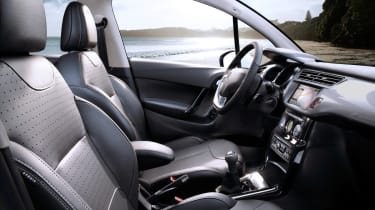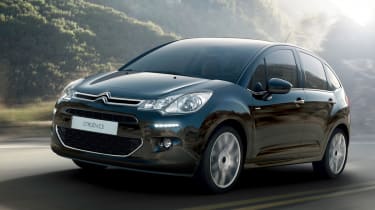Citroen C3 review (2009-2016)
The Citroen C3 is knocking on, and has a poor drive and lacklustre interior. It's practical and comfy though

Citroen used to be known for cars that were quirky, and while models such as the Grand C4 Picasso and C4 Cactus are a return to form in that respect, the Citroen C3 is a supermini that takes a more conservative approach.
The C3 is only available as a five-door, and that’s because Citroen decided to separate its more premium DS brand from the mainstream range. So while the DS 3 is the fashionable lifestyle-focused three-door, the young family-focused C3 hatchback takes the fight to worthy supermini rivals like the five-door Ford Fiesta, Vauxhall Corsa and Hyundai i20.
Families looking for an even more practical Citroen might also want to cast an eye over the C3 Picasso, which is the mini-MPV member of the family, and which takes on the Vauxhall Meriva and Nissan Note.
While the Citroen C3 and DS 3 share a platform and much of their mechanicals, the DS 3 is set up to give a more sporty and dynamic driving experience – so the differences are more than skin deep.
When the first generation C3 arrived in 2002, the range included a convertible model known as the Pluriel. The soft-top was canned in 2009 when the C3 was replaced with a new generation, but you can now get a DS 3 Cabrio instead. There have been changes since 2009, most notably a facelift in 2013, although the second-generation C3 retains its distinguishing panoramic windscreen with prominent quarter-lights, as well as its rounded side-profile.
Used - available now
There are quite a few engine options, including three-cylinder 1.0-litre and 1.2-litre petrol engines giving moderate performance, and a brace of 1.6-litre BlueHDi diesels. The latter are muscular and economical, but they also push the price up noticeably.
The current Citroen C3 range is available in four trim levels, called VT, VRT, VTR+ and Exclusive. Electric front windows, remote locking and a CD player are pretty much all you get in the basic VT specification, while the VTR+ (our choice) adds air-con, cruise control and a 'Zenith' windscreen, which extends even further back over the driver. Alloy wheels are included on most VTR+ models too. The range-topping Exclusive trim stands out with a full-length panoramic windscreen, climate control and Bluetooth.
In essence, the Citroen C3 is designed to do most of what you'd want a modern supermini to do. It looks decent enough, has a varied and economical engine range, and offers plenty of space. But it's getting on in years now and feels it, lagging behind the class best in terms of handling, tech and cabin quality. It isn't particularly cheap either, which would have gone some way to making up for the shortcomings.
Those needing more space and practical features should look at the Citroen C3 Picasso, while the upmarket DS 3 supermini and DS 3 Cabrio convertible should satisfy buyers looking for more individuality, performance and a better drive.
Engines, performance and drive
High speeds and motorway driving are handled pretty easily in the C3. It’s a refined long-distance cruiser, with one of the most comfortable rides in the sector. It’s softly set-up approach also pays dividends around potholed urban roads. The firm knows this is a priority for its customers, and we commend them for not following the 'sportier' trend of superminis.
But the trade-off is evident when you start to push the C3 even moderately hard, as the handling leaves a lot to be desired. The compliant suspension setup means the C3 rolls around in corners and the steering is quite vague, meaning it's pretty far away from the Ford Fiesta in terms of driver appeal. Indeed, it’s fair to say that many more up-to-the-minute rivals nail the balance between ride and handling much better.
Engines
The C3's latest three-cylinder PureTech petrol engines use direct injection technology and are designed to reduce weight along with running costs.
The C3 gets an entry-level 1.0-litre, 67bhp unit which is willing but a little sluggish for a larger supermini like this. It’s called the PureTech 68 and comes with a five-speed manual gearbox. 0-62mph takes 14.2 seconds and it’s flat out at 101mph.
Next up is the larger 1.2-litre PureTech 82 that boosts power to 81bhp and which also – in manual guise - offers 0-62mph in 14.2 seconds, but with a 108mph top speed. Its torque is higher than the 998cc unit though, so it has a little more grunt through the gears. The PureTech engine is also available with Stop & Start and an automated gearbox, but this makes little difference to the performance figures.
The most powerful petrol engine is the 109bhp PureTech 110 S&S, which only comes with five-speed manual gears and delivers 0-62mph in 10.6 seconds and a 118mph top speed.
The C3's diesel engines are impressively economical on fuel and give decent performance, but they’re considerably more expensive and we’d only recommended them for high mileage drivers. They're at least reasonably quiet units, however.
Both diesels are versions of the same turbocharged 1.6 litre engine, starting with the 74bhp BlueHDi 75, which does 0-62mph in 11.3 seconds and 106mph. The 98bhp BlueHDi 100 S&S has more grunt – 10.8 seconds and 117mph being its headline figures.
MPG, CO2 and Running Costs
The PureTech engines make the cheaper Citroen C3 models impressively efficient. The old four cylinder 1.1 VTi entry-level engine has been replaced by the more economical 1.0-litre VTi PureTech unit, which returns 65.7mpg.
Our choice, the 1.2 PureTech 82, produces 81bhp and manages 62.8mpg in fuel economy, making it competitive with the class average but not the best. Sadly the emissions are just over the threshold for free road tax, but the engine’s 104 g/km rating means it’s still cheap as chips to tax in VED group B.
The 1.2-litre PureTech 82 is almost as efficient in manual guise, offering a maximum ‘combined’ economy of 61.4mpg and CO2 of 107 g/km. However opt for the pricier automatic, which comes with Stop & Start tech, and useful tax savings are on offer thanks to a 99 g/km CO2 figure. Fuel economy is improved too, up to 65.7mpg. The range-topping petrol is the PureTech 110 – also with Stop & Start, but only available as a manual – and that one offers 62.8mpg.
The diesel engines are much more efficient as you would expect, although as they’re a couple of grand costlier than petrol equivalents you’ll need to be a high mileage driver to reap any running cost benefits. Still, it’s worth noting the BlueHDi 100 Stop & Start manual’s excellent official economy figure of 83.1mpg, with a CO2 level of 87g/km. The BlueHDi 75 is nearly as impressive too, with an 80.7mpg combined figure and 90g/km.
Insurance groups
The C3’s insurance should be pretty cost-effective, as the range sits in a band from group 8 to group 19. However some rival supermini ranges – including the VW Polo and Skoda Fabia have models that are cheaper to insure.
Depreciation
The C3 depreciation curve shouldn’t be as savage as some Citroens of old, and investing a bit more up front on a super-frugal diesel model is likely to help a bit too, come resale time. That said, a VW Polo – or even the sportier DS 3 – should hold its value better.
Interior, design and technology
The C3 was never an unattractive car to begin with, but the 2013 facelift addition of LED daytime running lights, a body-coloured splitter in the lower air intake and a bold double chevron grille freshened up the car’s stylish design.
Updated reflectors and taillights have also been fitted to the car’s rear end and the C3 is available in several striking body colours including the bold Ink Blue. It all helps to keep the car looking modern, but it's difficult to escape the feeling that Citroen's supermini is nearing the end of its life.
Inside, it looks adequately up-to-date with deep-set dials and colourful dash trim, while a large windscreen and bright dashboard make it feel light and airy. The range-topping Exclusive grade offers the panoramic Zenith windscreen, which extends back over your head for more light and an even airier feel.
While top-spec models offer plenty of glossy material to make them appear upmarket, if you poke and prod at a lot of the touch points they feel a little flimsy. The plastics below the normal line-of-sight levels look quite cheap, too.
It’s possible to order a black leather interior on the Exclusive model, as well as luxuries like automatic lights and wipers and an auto-dimming mirror, but even without such goodies, equipment levels feel generally decent as long as you opt for more than the entry-level VT spec. It means the C3 tends not to feel like a bargain basement car – but the price reflects this, too.
Sat-nav, stereo and infotainment
All versions of the Citroen C3 come with a radio and CD player with four speakers and steering wheel controls, but once above VT spec you can specify Bluetooth for hands-free phone calls and media streaming.
VTR+ and Exclusive models can also be had with an optional 7 inch Touchscreen, which includes satellite navigation and a reversing camera.
Practicality, comfort and boot space
The C3’s front seats are very adjustable and the plentiful head and legroom should also keep taller passengers happy. Visibility is great, thanks to thin pillars and that big windscreen, and with light steering and parking sensors it’s a doddle to use around town. The C3 is also quiet and refined at speed, which makes it a surprisingly comfortable cruiser thanks also to the soft ride. If you need to press on it’s less comfortable though, thanks to body roll and seats that lack side support.
There are various oddment compartments dotted around, although the door bins aren’t as big as we’d like. Unfortunately too, a large fusebox takes up most of the glovebox so you may need to find somewhere else to put your gloves. There also seems to be a lack of thoughtful practical touches in the cabin, like extra cupholders.
Size
The C3 hatchback is 3,941mm long, which makes it a little shorter than five-door versions of both the Hyundai i20 and the VW Polo which measure 4,035mm and 3,970mm respectively.
It sits between the pair at 1.728mm wide, but is noticeably taller than both – the C3 has a 1,538mm roof height, compared to 1,474 for the i20 and 1,462 for the Polo, and this contributes to the airy feel inside.
Leg room, head room & passenger space
As the C3 only comes with a five door body, getting in and out of the back is easy. As we’ve said, it’s also relatively tall for a supermini, so headroom in the rear is pretty good for the class.
There are three seatbelts on the rear bench, although it’s only really suitable for children ‘three-up’. Parents of smaller children will benefit from the standard Isofix mounts on the back seats, and of course accessing child seats is again made easier by the five-door format.
Boot
The Citroen C3’s height and clever packaging allow it to almost rival the larger Ford Focus in terms of cabin space. Suitcases and other bulky cargo can be stowed easily in its 300-litre boot which is only 16 litres smaller than the Focus, and larger than many in the supermini class.
If you fold the 60:40 split back seats you can increase boot space to an impressive 1,121 litres. The under floor storage area can hold the parcel shelf when the rear seats are folded but a large load lip makes loading bulky objects awkward.
Reliability and Safety
The C3 finished a disappointing 163rd place in our 2015 Driver Power survey. Part of that is due to its advancing years, but handling and build quality were particularly marked out by owners as being less than adequate.
On reliability the C3 didn’t fare too badly, with a score that ranked it 98th out of 200 cars – so just sneaking into the top 50%. Other than some trim quality issues and electrical quirks, the C3 seems to have remained relatively trouble-free mechanically. However there have been a number of recalls over its life, with issues such as fault brake servos, handbrakes and battery earthing among the most serious.
Citroen did climb 6 places as a manufacturer to 20th in 2015, but this is more likely to be because of improvements across the board in models newer than the C3. In spite of those improvements, reliability remains one of the areas that drags the manufacturer’s overall score down so there’s still work to do.
The C3’s safety rating isn’t all it might be either, having received only a four-star crash test rating from Euro NCAP when it was tested back in 2009, scoring just 40% in the safety assist category.
This is because ESP isn’t standard in the Citroen C3 range and is only an optional extra in the VTR+ and Exclusive models. The pedestrian safety score was only 33 per cent too. Driver, passenger and side airbags are included in all versions though, so at least the basics are covered, and the C3 scored quite highly for adult occupant safety at 83%. Child occupant safety was a less impressive 74%.
Warranty
Citroen offers a three-year/60,000 mile warranty across its line-up, including on the C3. This used to be par for the course, but latterly such offers are starting to look weak with rivals like Hyundai offering a five-year warranty package on the i20 with unlimited mileage. Citroen’s home rival Renault offers four years/100,000 miles on the Clio.
Servicing
If you drive a petrol C3 you can run the mileage up to 20,000 before you need a service, although the warranty demands you have an annual check if you don’t reach such heady mileages first. Diesel cars have shorter service intervals of 12,500 miles, but again require an annual check-up anyway. Servicing costs are competitive for the class, and there are fixed rate packages for up to three years if you pay in advance.















